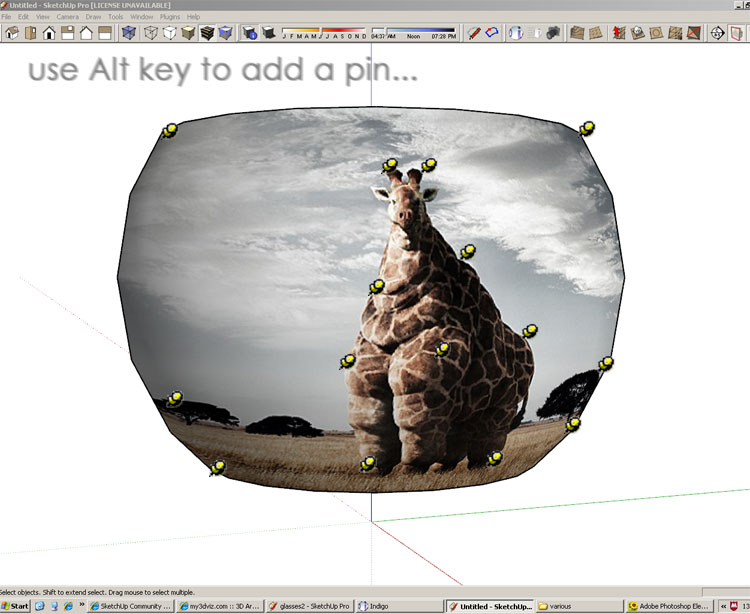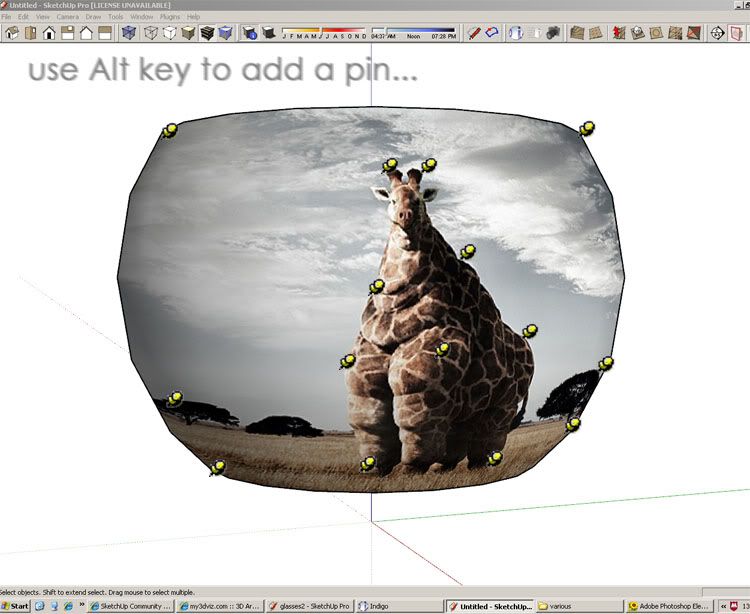Unfold.rb script: useful for UV-mapping?
-
This is an interesting thread, so in a nutshell what you are saying Chris is that say for instance the apple above, you first create the mesh then 'unwrap' it. You then export the 2d unwrapped image to an editor like Photoshop and you create the texture, the completed texture is then imported back into SU and applied to flattened mesh and then when folded the texture is perfectly mapped?
-
@solo said:
This is an interesting thread, so in a nutshell what you are saying Chris is that say for instance the apple above, you first create the mesh then 'unwrap' it. You then export the 2d unwrapped image to an editor like Photoshop and you create the texture, the completed texture is then imported back into SU and applied to flattened mesh and then when folded the texture is perfectly mapped?
Exactly, that's the idea.
-
Beibel
Mate yourn the money again! I thought about this the other day, even for simple models like context buildings or for examples like your idea for baked textures from podium. A simple form could be built and textured in SU - unwrapped - image edited to add details such as windows, doors etc and then rewapped to include the added details. Or when modelling with photomatch the unwrapped image could be edited easily to take out detail such as plants etc in the photo as needed to clean up the model.
Seems to me like a must for direct integration of SU for google with regards to google earth purposes!
I must say this really drives home the general need for better mapping functions in SU like spherical mapping!
-
@richard said:
Seems to me like a must for direct integration of SU for google with regards to google earth purposes!
Just mention Google earth some times more on the forum....maybe that wakes up the G-SU team

-
I Must say this idea is briliant, but instead of folding it back together why not try to make it like components? Unfold one, aplie texture and see the effect directly on another...
Would be awesome and very usefull!
-
Oh yes HFM,
Wonderful idea.
That way it would work like Whaat's subsmooth where you work on the proxy and the subsurface gets updated automatically. -
Too big silence from Jim's side IMO. I guess he is already thinking on it!

-
It could be mighty useful script.
-
what I truly would love to see is the possibility to add (and delete) pins to get an extended amount of control over the distortion of a texture (should of course work on curved surfaces too).

I think this idea was mentioned already somewhere in the forum.the workflow of unfolding a shape to texture it could work almost like adjusting a texture today in SketchUp:
you right click the object and choose "Texture > 2D Mapping" - then you get an unfolded version of the shape (while you still see a pale version of the original geometry- like the rest of a model is shown when you edit a component) with the texture projected on it. now you use the pins (or even add some...
 ) to position the image. then you hit "Enter" to confirm.
) to position the image. then you hit "Enter" to confirm.now that would be an incredibly easy but nevertheless flexible way of mapping textures!

-
 Plot Paris.
Plot Paris.
Your method with the pins would be simple and very effective.
Very Sketchup-like. -
I have downloaded the unfold .rb and it unfolds as expected, how does on refold back to original shape after that?
Is there anyway it can auto unfold and refold?
-
-
I think this can be done. I was meaning to ask Jim about this myself but you beat me to it, biebel!
Jim,
Manipulating uvs with the SketchUp API is very finicky. I gained a fair bit of experience with it when I implemented multiple UV sets in SkIndigo. I would be happy to help you out with this.
-

I smell a solution on the horizon!!
-
Cool!
By the way, I think Plot-Paris' suggestion about 'pin control' on 3D surfaces (just like we now have on 2D) is really worth investigating as well.It's by far the simplest concept, and no need to go to Photoshop.
I can imagine e.g having a sphere (or any other freeform), assigning a texture to it and moving pins around the spherical surface to 'correct' the distortions of the texture until it looks good. Than hit 'bake texture' (or just 'apply') and the new UV's are in place.
Just like it works now on 2D surfaces.
Awesome!
-
-
Make a cone shape and then project the texture attached below to the cone from above view, notice it will map the shape of the cone perfectly without distortion.

-
Oohhh... I am goosey all over...

This sure looks like an awesome feature..!!
Would LOVE to have this in SU...!!! -
I have been following, but I don't know the first thing about UV mapping.
@unknownuser said:

I'm not sure I understand how this image was created. I don't think it is a simple unfolding. Has there been some deformation of faces in order to close gaps?
-
That image derives from (soft) selecting parts of a 3D human body model.
The different selected groups (hands, head, etc...) are unfolded on their own so for each item a different texture can be made/edited in Photoshop. So the splitting up thing is user based. The smallest parts you see are finger joints, as they need refined Pshop maps applied etc...This example off course is the most complex one, where different parts of the model get unfolded seperately.
Solos sphere demonstration (see his images)or Howardshongs apple are somewhat closer to daily use in SU I guess, but the principle remains the same.The '3D Pin method' earlier described would even make it much more WYSIWYG, as you can directly see the effect of moving a pin on the 3D surface.
Stuff to think about
 ....
....
Advertisement









